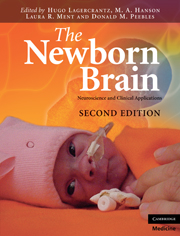Book contents
- Frontmatter
- Contents
- List of contributors
- Preface to the First Edition
- Preface to the Second Edition
- 1 Reflections on the origins of the human brain
- Section 1 Making of the brain
- Section 2 Sensory systems and behavior
- Section 3 Radiological and neurophysiological investigations
- Section 4 Clinical aspects
- Section 5 Follow-up
- 20 Injury and recovery in the developing brain
- 21 Development of motor functions in health and disease
- 22 Antenatal glucocorticoids and programming of neuroendocrine function and behavior
- Section 6 Consciousness
- Index
- Plate section
- References
22 - Antenatal glucocorticoids and programming of neuroendocrine function and behavior
from Section 5 - Follow-up
Published online by Cambridge University Press: 01 March 2011
- Frontmatter
- Contents
- List of contributors
- Preface to the First Edition
- Preface to the Second Edition
- 1 Reflections on the origins of the human brain
- Section 1 Making of the brain
- Section 2 Sensory systems and behavior
- Section 3 Radiological and neurophysiological investigations
- Section 4 Clinical aspects
- Section 5 Follow-up
- 20 Injury and recovery in the developing brain
- 21 Development of motor functions in health and disease
- 22 Antenatal glucocorticoids and programming of neuroendocrine function and behavior
- Section 6 Consciousness
- Index
- Plate section
- References
Summary
Introduction
Glucocorticoids (cortisol in humans and most mammals, and corticosterone in rats, mice, and other lower vertebrates) are essential for normal brain development. They exert a wide spectrum of effects in most regions of the developing brain, ranging from subcellular reorganization to neuron–neuron and neuron–glial interaction. However, sustained elevation in, or removal of these hormones from, the fetal brain is detrimental to these processes, and can permanently modify the structure and function of the brain (Charmandari et al., 2003).
The pioneering work of Liggins and Howie in the early 1970s led to the widespread use of synthetic glucocorticoids to treat fetuses at risk of preterm delivery (Liggins & Howie, 1972). Preterm delivery occurs in approximately 7% of pregnancies in North America and results in approximately 75% of all neonatal deaths. In such cases, antenatal synthetic glucocorticoid therapy, administered between 24 and 34 weeks' gestation is highly effective in reducing the frequency of respiratory complications and perinatal death (National Institutes of Health [NIH] Consensus Panel, 1995). In 1994, the NIH endorsed the use of maternal synthetic glucocorticoid therapy during pregnancy (NIH Consensus Panel, 1995) and a similar approach was adopted around the world. Due to difficulty in predicting preterm birth, many women received repeat courses of synthetic glucocorticoids. Indeed, surveys in the late 1990s revealed that repeated dosing had become common practice in the late 1990s, with some women receiving up to 11 repeat courses (Brocklehurst et al., 1999).
- Type
- Chapter
- Information
- The Newborn BrainNeuroscience and Clinical Applications, pp. 361 - 376Publisher: Cambridge University PressPrint publication year: 2010



